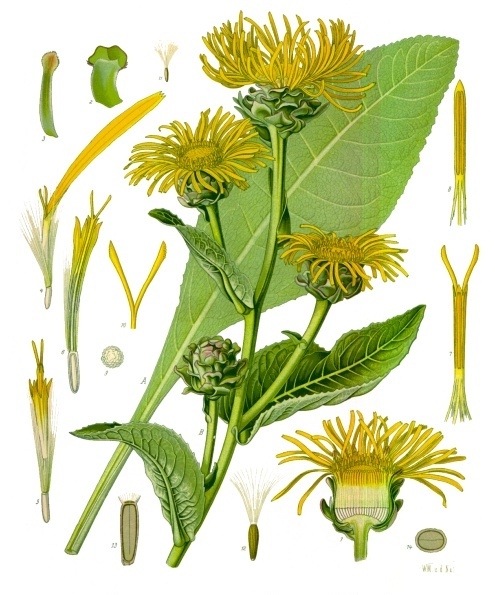- Elecampane
Taxobox
name = Elecampane

image_width = 250px
regnum =Plantae
phylum =Magnoliophyta
classis =Magnoliopsida
ordo =Asterales
familia =Asteraceae
tribus =Inuleae
genus = "Inula "
species = "I. helenium"
binomial = "Inula helenium"
binomial_authority = L.Elecampane, also called Horse-heal ("Inula helenium") or Marchalan (in Welsh), is a perennial
composite plant common in many parts ofGreat Britain , and ranges throughout central andSouthern Europe , and inAsia as far eastwards as theHimalayas .It is a rather rigid
herb , the stem of which attains a height of from 3 to 5 feet; theleaves are large and toothed, the lower ones stalked, the rest embracing the stem; theflower s are yellow, 2 inches broad, and have many rays, each three-notched at the extremity. The root is thick, branching and mucilaginous, and has a warm, bitter taste and acamphoraceous odor .For
medicinal purposes it should be procured from plants not more than two or three years old. Besidesinulin , C6H12O6(C6H10O5)n, a bodyisomeric withstarch , theroot containshelenin , C15H20O2, astearoptene , which may be prepared in white acicularcrystal s, insoluble in water, but freely soluble inalcohol . When freed from the accompanying inula-camphor by repeated crystallization from alcohol, helenin melts at 110 °C. By the ancients the root was employed both as a medicine and as acondiment , and inEngland it was formerly in great repute as an aromatic tonic and stimulant of the secretory organs. As a drug, however, the root is now seldom resorted to except inveterinary practice, though it is undoubtedly possessed ofantiseptic properties.In
France andSwitzerland it is used in the manufacture ofabsinthe .Recent science
Susan O'Shea, a research student at
Cork Institute of Technology (CIT), Ireland, has shown that extracts from the herb kill methicillin-resistant "Staphylococcus aureus" as well as a broad spectrum of otherbacteria . [http://www.irishexaminer.com/irishexaminer/pages/story.aspx-qqqg=ireland-qqqm=ireland-qqqa=ireland-qqqid=48105-qqqx=1.asp Newspaper report of the discovery]Folklore
The plant's specific name, "helenium", derives from
Helen of Troy ; elecampane is said to have sprung up from where her tears fell. It was sacred to the ancientCelts , and once had the name "elfwort". [Howard, Michael. "Traditional Folk Remedies" (Century, 1987); p135]Herbalism
John Gerard recommended elecampane for "the shortness of breath"; today herbalists prescribe it as anexpectorant and forwater retention ; it also is claimed to haveantiseptic properties. It has minor applications as atonic and to bring onmenstruation . [Howard, Michael. "Traditional Folk Remedies" (Century, 1987); p136]References
Wikimedia Foundation. 2010.
